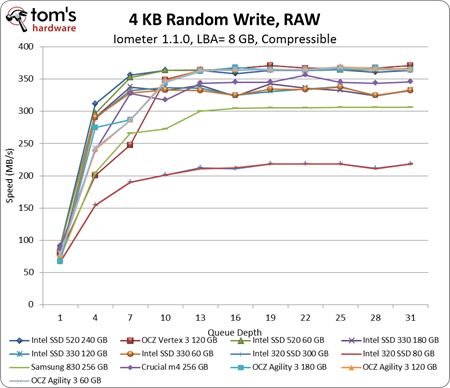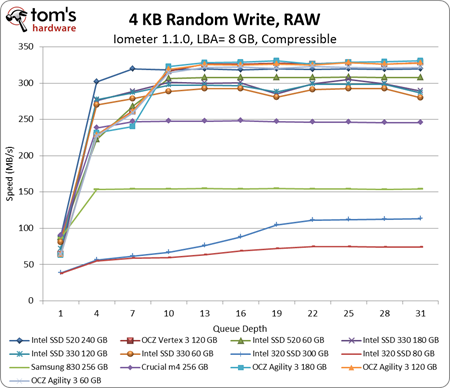Intel SSD 330 Review: 60, 120, And 180 GB Models Benchmarked
Benchmark Results: 4 KB Random Performance
Random Read Performance (background info)
Examples include antivirus scans and typing in Word
We've spent time with a great many SandForce-based SSDs, and we know that two drives that share the same NAND interface also share the same performance characteristics, regardless of the brand on the label.
Our goal here is to dig into the SSD 330's performance. However, presenting lots of throughput data on a graph ends up with too many products falling too close together, resulting in a ton of clutter. So, we're simply using Intel's SSD 520 and and OCZ's Agility 3 to represent SandForce-based SSDs with synchronous and asynchronous memory. We're also using a 120 GB Vertex 3 because we're missing the SSD 520 at that capacity point.
Incidentally, the SandForce-based SSDs deliver comparable maximum random read performance, regardless of NAND type. In the chart above, the SSD 520, Vertex 3, and Agility 3 all top-out around 360 MB/s. The SSD 330 is an exception, and it "only" achieves roughly 330 MB/s. This places Intel's newest model ahead of Samsung's 830, but behind Crucial's m4.
With only one outstanding I/O command, the SSD 520, Vertex 3, m4, and 830 all deliver about 75-90 MB/s, while the SSD 320, SSD 330, and Agility 3 start out at roughly 66-68 MB/s.
Random Write Performance
Get Tom's Hardware's best news and in-depth reviews, straight to your inbox.
Examples include email, file compression, and Web browsing
At a queue depth of one, the SSD 330s deliver ~70-80 MB/s, nudging Intel out in front of OCZ's Agility 3, which does ~60 MB/s. Yet, the SSD 330 is still slower than the SSD 520, Vertex 3, m4, and 830, all which push between 80-90 MB/s.
Higher queue depths paint the SSD 330 in a more favorable light. While the SSD 520, Vertex 3, and Agility 3 all do very well, the SSD 330 only trails by ~10-20 MB/s, showing that even Intel's lower-end drives aren't quantifiably penalized in random write performance.
Current page: Benchmark Results: 4 KB Random Performance
Prev Page Test Setup And Benchmarks Next Page Benchmark Results: 128 KB Sequential Performance-
Au_equus I bought this samsung 830 256gb ssd for $390 five-six months agoReply
http://www.newegg.com/Product/Product.aspx?Item=N82E16820147164
now its $275 or $1.074/GB. Better price/stability/performance than those listed above. -
phamhlam au_equusI bought this samsung 830 256gb ssd for $390 five-six months agohttp://www.newegg.com/Product/Prod 6820147164now its $275 or $1.074/GB. Better price/stability/performance than those listed above.Reply
Crucial m4 128GB from Newegg and Amazon @ 124.99. That is less than $1/GB. -
One question, which didn't explained: what Intel SSD is better for SATA 3Gb/sec 320 or 330 series?Reply
-
blazorthon Intel should have used non-SandForce controllers. The Vertex 4 (with the new firmware) shows what Sandforce alternatives are capable of, I hope that Intel's next flagship series does something similarly spectacular without Sandforce. I think that Intel could have used the 330s as a stepping stone to get a controller (such as a Marvell controller) up to Vertex 4-like performance (or better) in more universal workloads than Sandforce for their next flagship series.Reply
On that note, why weren't the Vertex 4s included in this review with the other drives? -
blazorthon EoveinOne question, which didn't explained: what Intel SSD is better for SATA 3Gb/sec 320 or 330 series?Reply
I don't think that it makes much difference at SATA 3Gb/s, but the 330s are faster drives, so they might be marginally better. -
blazorthon chimera201When will the price of SSD come down to HDD level? That would be news.Reply
Probably at least not until a cheaper memory than Flash is used in SSDs, so maybe ten to twenty years, if we're lucky. -
EDVINASM Am not a mad scientist or anything so I have missed something but to me Intel SSD is as good as any others on the market. I wouldn't see any difference in real world scenario between 330 and 520 or Samsung 830 or even M4. Who cares? I don't anyway. Just get the drive that you trust and that has reasonable warranty (3 years +) and good support. Done.Reply -
blazorthon edvinasmAm not a mad scientist or anything so I have missed something but to me Intel SSD is as good as any others on the market. I wouldn't see any difference in real world scenario between 330 and 520 or Samsung 830 or even M4. Who cares? I don't anyway. Just get the drive that you trust and that has reasonable warranty (3 years +) and good support. Done.Reply
Whether or not a part that is faster for your workloads than others and is faster enough to make a difference depends on what you are doing. If I was doing a lot of storage heavy stuff, like constantly downloading and decompressing large archives, then an SSD that can deal with in-compressible data very well would provide very noticeable gains over any SandForce drive or any lower end non-Sandforce drives. -
EDVINASM blazorthonWhether or not a part that is faster for your workloads than others and is faster enough to make a difference depends on what you are doing. If I was doing a lot of storage heavy stuff, like constantly downloading and decompressing large archives, then an SSD that can deal with in-compressible data very well would provide very noticeable gains over any SandForce drive or any lower end non-Sandforce drives.Reply
Fair point. Mind you, if you do that much and it's that important hardly any of standard (consumer grade) SSDs would interest you. Unless you are talking of downloading software and games from questionable sites, then yes - cheap and fast is cheerful.

